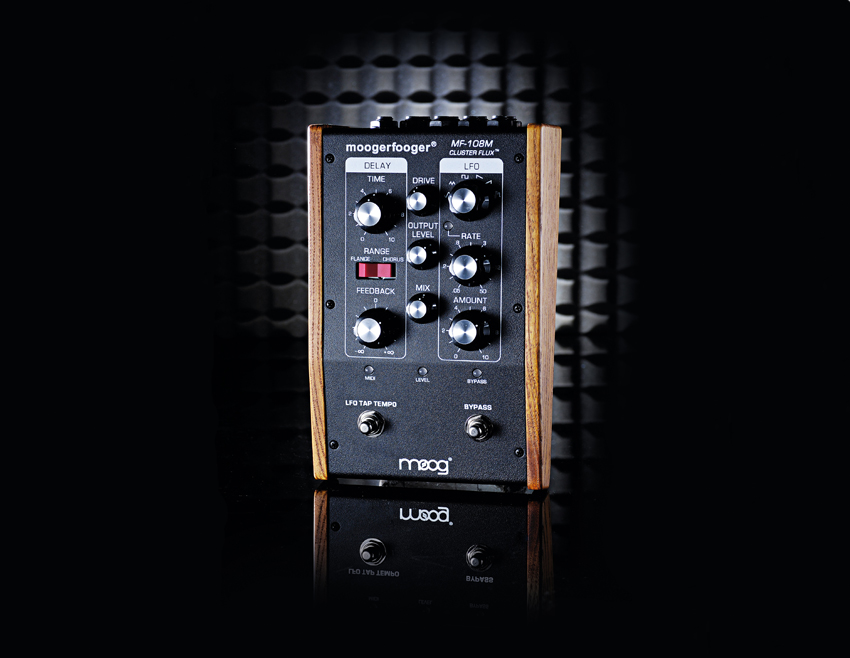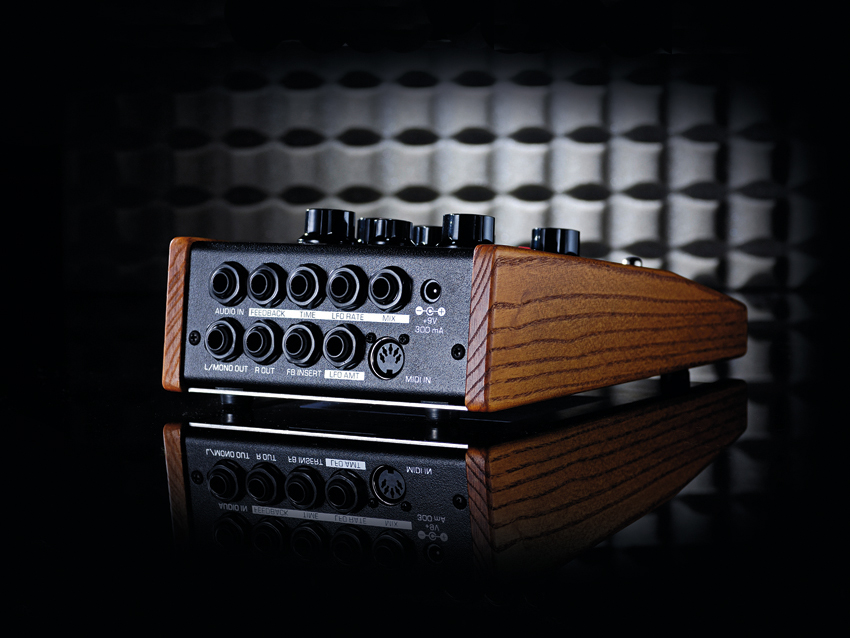MusicRadar Verdict
Another superb addition to the MoogerFooger line that should prove highly desirable
Pros
- +
A great tool for harmonic manipulation. Simple and effective processors. Full sounding preamps with plenty of clean gain.
Cons
- -
No on/off switch.
MusicRadar's got your back

Moog MF-108M Cluster Flux

Moog MF-108M Cluster Flux
The latest transmission put forth by Moog Music arrives in the form of another chunky MoogerFooger unit, adding to the ever-lengthening line of analogue kit they've produced over the past forty plus years. This pedal sets about mashing up delay-based effects with multi-form LFO modulations to produce complex yet playable chorus, vibrato and flanging sounds.
Built up from the remaining supply of high-voltage Panasonic Bucket Brigade Delay (BBD) chips that are still out there, the MF-108M is designed to deliver those uber-clean and highly desirable chorus/flanger effects in a package that's as classically modular as it is classically Moog.
"The real fun to be had here comes from more adventurous twiddling."
With its solid organic-meets-industrial housing, sturdy knobs and switches, plus the flexibility that comes from both MIDI and control voltage (CV) manipulation, we are instantly set to wondering if this is the last ever chorus/flanger pedal that we need think about owning.
Time and space
From left to right, the Cluster Flux is laid out simply enough. The first column houses the delay section
that includes continuous Time and Feedback pots, along with a red rocker switch to move between chorus and flange. Three mini-pots in the centre section cover input (Drive), output (Output Level), and Mix functions.
In the remaining column is the rotary switch selecting which waveforms (Sine, Triangle, Square, Sawtooth, Ramp and Random Stepped) are available to the LFO waveforms, and two more pots under it adjust the oscillator's Rate and Amount.
Three independent LEDs below the controls reflect MIDI activity, level intensity and whether the unit is bypassed (red) or in play (green). Beneath them the LFO Tap Tempo and Bypass switches complete the face of the MoogerFooger's control panel.
Round the back of the unit are a good number of 1/4" jack points. CV inputs for Feedback, Time, LFO Rate, Mix, and LFO Amount sit alongside Left and Right outputs, a MIDI jack, and a Feedback Insert (which allows the feedback signal path to be processed separately via a standard 1/4" TRS patch cable).
But gah! there is no on/off switch. The MF-108M relies solely on its standard +9V 300 mA wall wart to power up and down. That aside, the 4lbs/1.8kg build of the MF-108M is rugged and should live comfortably either on the floor alongside your bog standard stompboxes or racked up with the keyboards make up your current rig.
Sound and vision
In order to key you in quickly to the sonic possibilities of the MF-108M, Moog have include a handful of useful patches, all nicely illustrated in the manual, to get you started with the Cluster Flux.
You can dive straight in with a classic flanger effect built up from a healthy amount of triangled LFO to hear the rich, jet-like sound that takes you back to Bowie's Station to Station or the Beatles' Blue Jay Way.
The straight out of the tin chorus is equally lush, and free of the tinny digital vibe that many '80s guitarists who fell prey to the more inexpensive analogue emulators are unable to escape.
Plus, if you're so inclined, the internal dip switches inside the Cluster Flux enable you to reconfigure the Right output on the back of the unit to allow for the standard mix of the dry signal and phase inverted wet signal to be changed for more sound shaping control (for example: right output dry and mix disabled with the wet signal in phase).
With those fairly basic settings test-driven, the real fun to be had here comes from more adventurous twiddling.
Take, for instance, dialing up a square wave for the LFO, setting the red rocker switch to Chorus and then adding fair amounts of Time and Feedback to a warm pad chord while you subtly twist the LFO Amount knob back and forth. Even minor adjustments to this sort of Square Wave Chorus configuration can wind up being rhythmically satisfying.
Reassuringly expensive
The same can be said of employing the Random wave in flange mode while tweaking the amount of Feedback run through the signal. With the LFO Rate and Amount set fairly high the Cluster Flux produces wonderfully interesting types of modulation as you approach either the positive or negative extreme of the Feedback pot - even when you're simply messing around with pink noise!
In terms of live performance the Tap Tempo knob is quite responsive as well.
Once you've gauged where you need the LFO rate to be, the MF-108M usually falls in line by the third time you've tapped the switch. For those with either Moog's EP-2 Expression Pedal or a similar device, you can create wah-wah like effects, especially with some of the flange settings.
As for DAW integration, you can control the Cluster Flux's settings via MIDI CC messages to allow for tempo syncing direct from your sequencer of choice.
Beyond the obvious advantages of this, you can also extend what the device can do on its own, via specific CC messages such as multiplying the available delay time range for a broader selection of echo effects or controlling specific rhythmic clock divisions (dotted 1/8 note or 1/16 triplet, for example).
Moog maintain that they plan on keeping the Cluster Flux in production as long as their supply of BBD chips holds out.
So while this unit, like the rest of the MoogerFooger line, does maintain a relatively full-on price tag, its modular flexibility combined with that highly desirable analogue sound might make it worth stretching your kit budget.
Future Music is the number one magazine for today's producers. Packed with technique and technology we'll help you make great new music. All-access artist interviews, in-depth gear reviews, essential production tutorials and much more. Every marvellous monthly edition features reliable reviews of the latest and greatest hardware and software technology and techniques, unparalleled advice, in-depth interviews, sensational free samples and so much more to improve the experience and outcome of your music-making.
“Without investment in music education our talent pipeline is at risk of drying up along with the huge opportunities for economic growth it brings”: UK Music draws up five point plan to “turbocharge” music education
“How daring to have a long intro before he’s even singing. It’s like psychedelic Mozart”: With The Rose Of Laura Nyro, Elton John and Brandi Carlile are paying tribute to both a 'forgotten' songwriter and the lost art of the long song intro
“The verse tricks you into thinking that it’s in a certain key and has this ‘simplistic’ musical language, but then it flips”: Charli XCX’s Brat collaborator Jon Shave on how they created Sympathy Is A Knife










